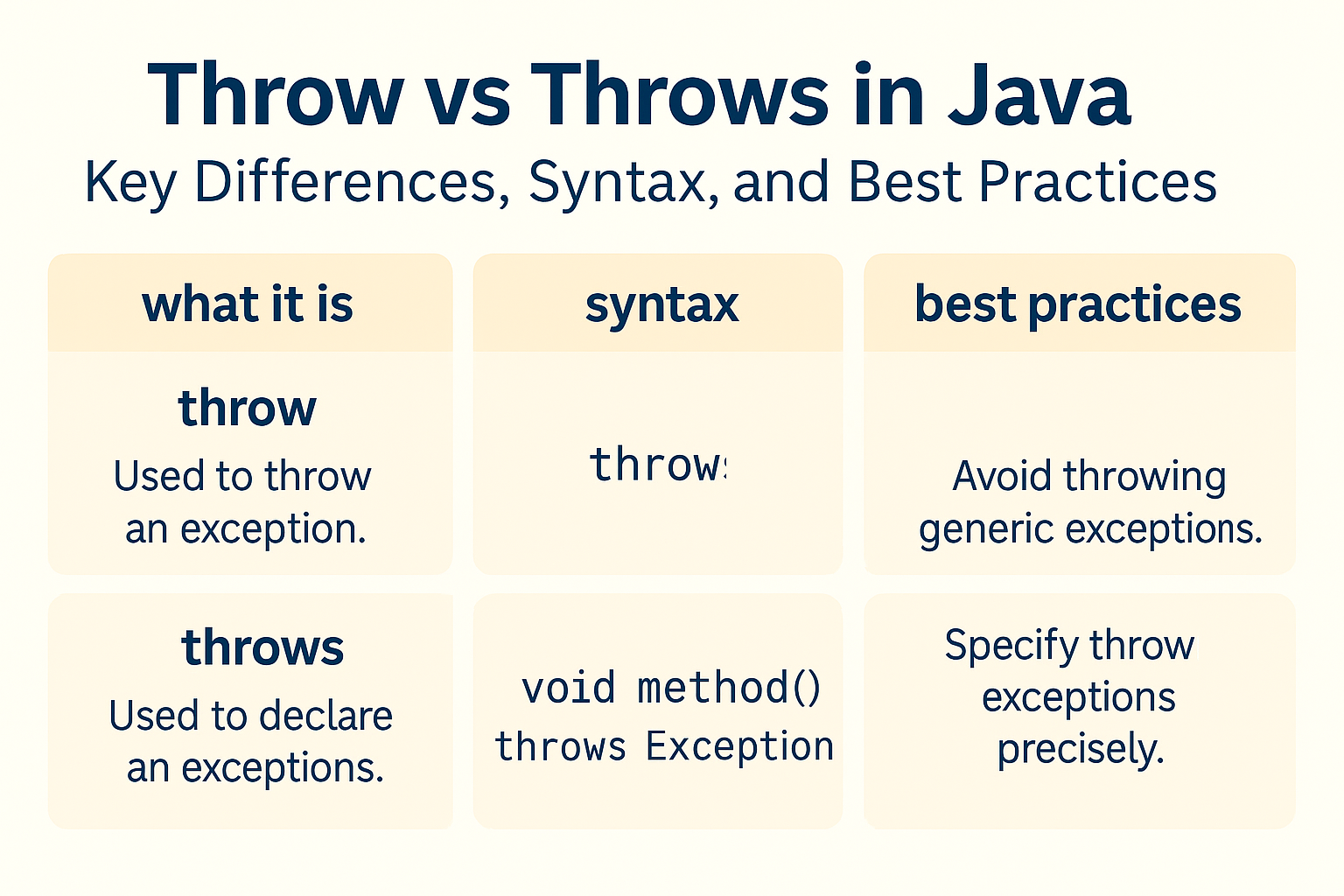Introduction
Exception handling is a critical part of writing robust Java applications. Two commonly confused keywords are throw and throws. While they sound similar, they serve different purposes in exception management. Understanding their differences helps you design cleaner, safer, and maintainable code.
In this tutorial, we’ll explore what throw and throws are, their key differences, real-world use cases, common mistakes, and best practices with detailed code examples.
What is throw in Java?
The throw keyword is used to explicitly throw a single exception from a method or block of code. It is followed by an instance of Throwable or its subclasses.
Syntax:
throw new ExceptionType("Error message");
Example:
public void validateAge(int age) {
if (age < 18) {
throw new IllegalArgumentException("Age must be 18 or above.");
}
System.out.println("Valid age: " + age);
}
✅ Key Points:
- Used inside a method or block.
- Can throw only one exception at a time.
- Must throw an object of
Throwableor its subclass. - Control immediately transfers to the nearest catch block.
What is throws in Java?
The throws keyword is used in a method declaration to indicate that the method might throw one or more exceptions. It informs the caller to handle these exceptions.
Syntax:
public void methodName() throws ExceptionType1, ExceptionType2 {
// code
}
Example:
public void readFile() throws IOException {
FileReader file = new FileReader("data.txt");
file.close();
}
✅ Key Points:
- Declares exceptions a method can throw.
- Can specify multiple exceptions separated by commas.
- Used only in method signatures, not inside code blocks.
Key Differences Between throw and throws
| Feature | throw |
throws |
|---|---|---|
| Usage | Used inside a method or block to throw an exception. | Used in method declaration to declare exceptions. |
| Number of Exceptions | Can throw only one exception at a time. | Can declare multiple exceptions. |
| Followed By | Followed by an instance of an exception. | Followed by exception class names. |
| Position | Appears inside method body. | Appears in method signature. |
| Compile-Time Check | Must be used for both checked and unchecked exceptions. | Only required for checked exceptions. |
Real-World Analogy
Think of throw as actually throwing a ball (exception) to someone (caller), while throws is a warning sign saying, "This method might throw a ball, be ready to catch it!".
When to Use throw vs throws
- ✅ Use
throwwhen you want to create and throw an exception at a specific point in your code. - ✅ Use
throwswhen writing methods that might propagate exceptions to the caller without handling them immediately.
Performance and Memory Implications
- Frequent use of
throwin loops can create performance overhead due to repeated object creation. - Declaring too many exceptions in
throwscan make the API harder to use and maintain. - Prefer custom exceptions to avoid confusion.
Common Mistakes and Anti-Patterns
❌ Using throw with primitive types:
throw "Error"; // Compilation error
✅ Always throw an object of Throwable or subclass.
❌ Declaring throws Exception everywhere:
- Makes the code less readable and forces unnecessary exception handling.
Code Example: Combining throw and throws
public void processFile(String path) throws IOException {
if (path == null) {
throw new IllegalArgumentException("Path cannot be null");
}
FileReader fr = new FileReader(path);
fr.close();
}
Interview Questions
-
Q: Can you use
throwto throw multiple exceptions?
A: No.throwcan throw only one exception instance at a time. -
Q: Can
throwsbe used with constructors?
A: Yes,throwscan be applied to constructors as well. -
Q: Is
throwsmandatory for unchecked exceptions?
A: No, it’s optional for unchecked exceptions but required for checked exceptions.
Best Practices
- Use meaningful custom exception messages.
- Prefer specific exceptions over generic ones.
- Avoid overusing
throws Exception. - Always document your exceptions for maintainability.
Conclusion
Understanding the difference between throw and throws helps you write robust, clean, and maintainable Java applications. throw is about actually throwing an exception, while throws is about declaring potential exceptions.
FAQ
Q1: Can we use throw without throws?
Yes, for unchecked exceptions, you don’t need throws in the method declaration.
Q2: Can a method use both throw and throws?
Yes, a method can declare exceptions with throws and use throw to throw them.
